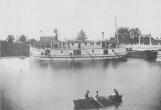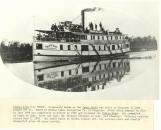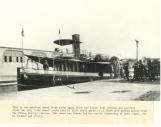19
Moss Kent Dickinson was known as the "King of the Rideau" & had many boats travelling on the Rideau.1870-1890
Rideau Canal, Ontario, Canada

21
Transportation, Settlement Patterns, and the Resurgence of ManotickThe Canal and the Rideau River had been the favoured method of transportation for passengers and merchandise for many years. Manotick had an advantageous location: First Class Passage and Freight steamers passed by on a regular basis and the government had built a draw bridge across the Rideau River opposite the village.
Until about 1862, only a small scow or ferry transported people and animals across the west channel. It also enabled farmers to deliver grain to the mill. On the opposite channel, a ferry service operated between the Eastern Shore and the mainland. Dickinson acquired it and added a wharf to facilitate the delivery of his products from his mills. He had ample storage sheds, a storage cooper and carpenter shops, stables and barns, and several houses for his employees. Between 1866 and 1868 a swing bridge was built across the back channel. This was replaced in 1956 by a high level concrete bridge that is still in use today.
The addition of the railroad to Manotick greatly expanded its industry. Farmers and loggers made money by cutting wood for the steam engines. The first train arrived at Manotick Station in 1854. Barney McCarney was well known as the operator of the passenger and mail service between the railway at Manotick Station and the village. The railway was faster and more efficient than the canal; the canal's use was declining. The United States market was no longer wanting as much Canadian goods. As a result, Dickinson sold his Ottawa and Rideau Forwarding Company in 1869. It was the end of an era for the Rideau. The growth of Manotick halted.
The last half of the 20th century has given Manotick a new impetus for development. In 1867, Manotick had a population of c. 200 and in 1880, approximately 400. In 2001, the Village of Manotick became part of the City of Ottawa, bringing the population to an official 750 000. Today, as people seek to get further away from the city, seeking small town charm, Manotick continues to grow.





